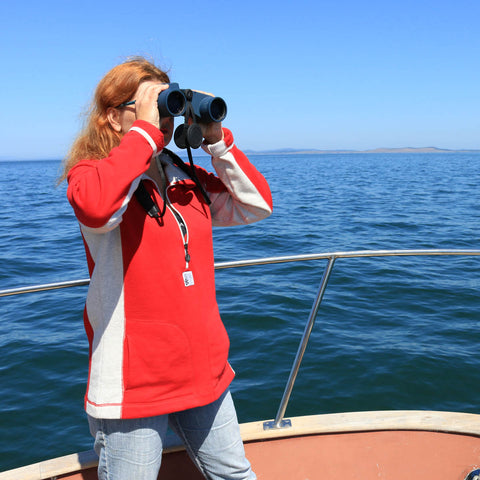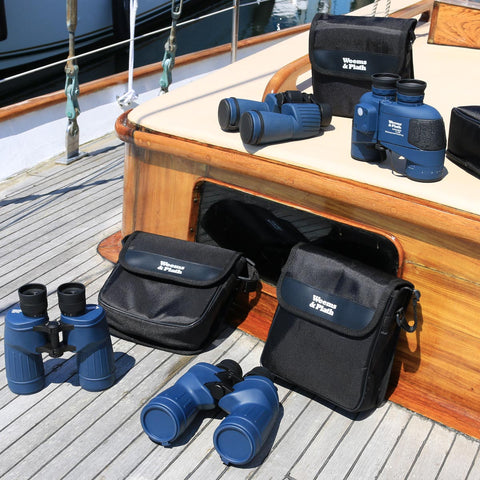

Our upfront disclaimer is we do not consider ourselves "binocular snobs". Or binocular experts. But after using our Weems & Plath Explorer binoculars for a few years now, we have definitely become proponents of good quality marine binoculars.
About 12 years ago when we lived in Friday Harbor, Lisa and I purchased a lovely 33-foot pilothouse double-ender for sailing and cruising around the Salish Sea. While the new-to-us s/v Venus came equipped with radar, an autopilot, and an essentially brand new Vetus diesel engine, like most used vessels we had to buy some additional gear. Among the list of things to get was a pair of binoculars. So off we went down to our local unnamed national marine store chain (brownie points if you can guess the name :-). They had a small selection of binoculars from inexpensive to pretty darn expensive.
Now if you've ever purchased a used boat before, and you had to outfit said boat with some new gear and accessories, you probably can relate to the fact we didn't have an unlimited budget for such things. So we opted for the least expensive pair of binoculars, which also happened to be the store's own brand. Knowing that they purchased the binoculars from an actual manufacturer and just put their logo on them, we figured they'd be "good enough".
And honestly, they were.

Until we picked up a pair of Weems & Plath binoculars at the Annapolis Boat Show and intuitively felt the difference. Even though we were thousands of miles away from home and our generic binoculars, we could immediately tell these new binoculars were of much higher quality. So we splurged. At least it felt like it, as the new Weems & Plath binoculars were a couple hundred dollars more than our other pair. You know that old saying, "you get what you pay for"? Well, when it comes to binoculars, and marine binoculars in particular, that adage is quite true.
The first time we needed to use the Weems binoculars approaching a marina at dusk was the moment we realized our new binoculars were much better than our old ones. The field of view was so much brighter than we were used to due to the superior optics, allowing us to make out slip numbers before entering the fairway. We even did a side-by-side comparison which made the difference even more pronounced.
We had already been selling the Weems & Plath SOS Distress Light in our store, Pacific NW Boater TESTED, and after more thorough testing we became so enamored with our new binoculars we decided to offer the entire line of Weems & Plath Marine Binoculars as well.
Beyond that video, there is quite a bit of information that you should know about binoculars which will help you make an informed buying decision. Since we are not experts, we're going to let Weems & Plath give you a bunch of detailed information on what makes a good binocular good. This is basic information you should have in hand no matter what brand you are looking to purchase (alternatively, you can download their PDF "Definitions of Binocular Terms"):
Magnification: Binoculars are described using two numbers. Most marine binoculars are 7x50. The first number, in this case, seven (7), indicates magnification (power), and the second number, fifty (50), is the objective lens diameter in millimeters. This power which makes things appear seven times closer than they really are is generally accepted to be the highest practicable power for use on the deck of a moving boat.
Eye relief: The maximum distance between the surface of the eyepiece lens and your eye at which you can still discern the full field of view is called eye relie£ Most binoculars have a standard eye relief distance of9mm to 12mm. This is long enough unless you wear eyeglasses. All our binoculars feature longer eye relief, from 15mm to 23mm, which benefits people who wear eyeglasses. It is also an advantage for those who don't wear glasses so they don't have to press hard against the eyecups to see the whole field of view.
Exit pupil: The exit pupil is the circle of light you see when holding binoculars about 6 inches away from your eyes and looking at the surface of the eyepieces. The larger the exit pupil, the brighter the image obtained will be. Having a large exit pupil is advantageous under low light conditions and at night. The exit pupil is a measurement that can be calculated by dividing the diameter of the objective lens by the magnification. Hence, using 7x50 binoculars as an example, the exit pupil measurement is: 50 divided by 7 = 7.14.
Purge gas: For improved light transmission and to prevent fogging, moisture, and leakage, binoculars are filled with an inert gas. Both Argon and Nitrogen are used in our binoculars. Dry Nitrogen is the standard gas used in the industry to prevent fogging. Argon is better because it does not react with the binocular internal parts.

Field of view: The size of the area that can be seen while looking through a pair of binoculars is referred to as the "field of view". Field of view can be expressed as an angle or a distance that can be observed at 1000 yards. A larger field of view translates to a larger area seen through the binoculars.
Lens Coatings: Binoculars have a sophisticated combination of lenses and glass surfaces both inside and outside the housing. To maintain brightness, sharpness and image contrast, lens coatings are applied using thin layers of chemicals. Our binoculars use two coating options that offer the best light transmission efficiency available.
Fully Coated (FC): All air-to-glass surfaces have been coated with a single chemical layer. Fully coated lenses offer very good light transmission.
Fully Multi-Coated (FMC): All air-to-glass surfaces have received multiple coatings. Fully multicoated lenses give the best light transmission and brightest images. Compass: Built-in magnetic compasses, which appear superimposed near the image you see through the lens, let you take compass bearings of an object. This is valuable to determine your location relative to other objects.
Reticle: Built-in range-finding reticle allows you to calculate the distance from an object of a known height. Combined with the bearing, this will determine your position.
Prism: To invert and magnify an upside-down image, we use two types of prism systems for the best quality optics, the porro prism and the roof prism. By design, roof prisms are more compact and lightweight than porro prisms. Porro prisms offer superior optical performance, but the roof prism used in the Apache is coated with an anti-phase shift coating which is equal in quality to the porro prism. The glass type used in Weems Binoculars is the best available BAK4, a barium crown glass, a fine glass with high density, that eliminates internal light scattering and produces sharper images than other glass types.
Once you decide to purchase your new Weems & Plath binoculars from our store, here's a short video from Weems & Plath on how to set up and get the most out of your new, high-quality optics:
From the above Weems & Plath video, here's the information in written form on the proper focus technique (also found on the PDF "Definitions of Binocular Terms"):
Center Focus: The center focus system of our Sport BN10 binoculars allows you to change focus quickly between objects near and far by turning the center focus wheel. To focus using the center focus system: A. Close your right eye and look through the left side of the binoculars. Focus by turning the center focus wheel until the image is clear. B. Close your left eye and look only through the right side of the binoculars and turn the right eyepiece focusing ring until the image is clear. C. Now, your binoculars should be adjusted for your eyes. Focusing for both far and near objects can be made by simply turning the center focus wheel.
Individual Focus: The advantage of individual focus binoculars is that you can pre-focus the binoculars allowing you to see objects in low light without further adjustments for distances of 40 yards to infinity. To focus using individual focus system, close one eye and rotate the eyepiece adapter ring until the image is sharp, then repeat for the other side.
There! Now that you're as much a binocular expert as we are, you can get $50 OFF each Weems & Plath marine binocular model in our store. Simply use the promo code WEEMSBINOCULARS during check out. There's no limit (meaning you can use the code more than just once), and you can definitely let your friends know about it, too.
And be sure to check out the rest of our store's great Pacific NW Boater TESTED Weems products with our Weems & Plath Collection.
Thanks for reading, and we'll see you out on the water. (Using your new Weems & Plath binoculars, of course!)
Comments will be approved before showing up.

Memories are made on the water. Often it's the skipper's (Dad's) job to ensure everyone has a good time and arrives safely at the end of the day or journey. Usually the thanks Captain/Dad gets is in the form of satisfied, happy faces. Which is enough! We decided to take that one step further, however, and made a collection of 12 items that show just how much you appreciate everything he does.

As of today, Section 301 Tariffs have impacted more than 300 commonly used components, materials, and parts for recreational boats in the United States (source, National Marine Manufacturers Association). Even our little online store is beginning to see price increases and supply chain disruptions...

Darren O'Brien
Author